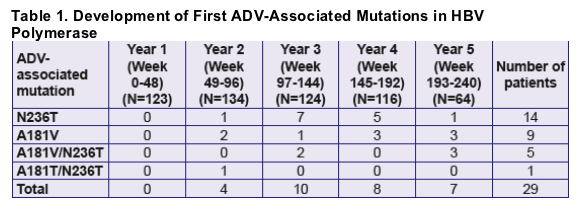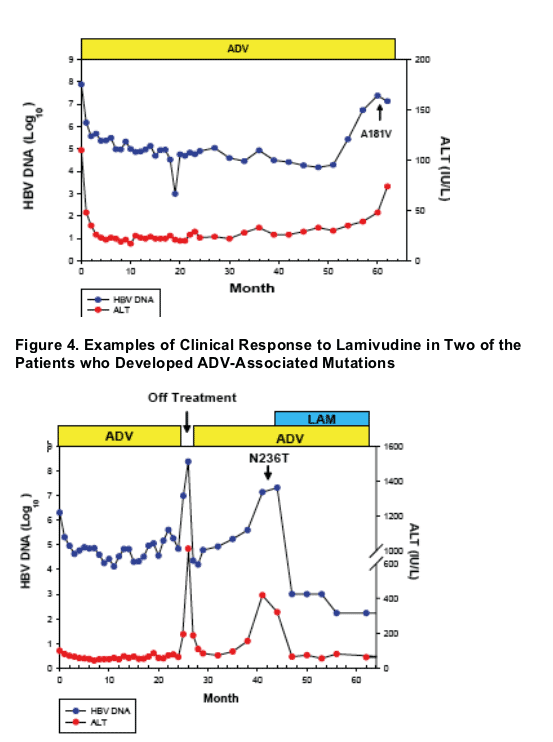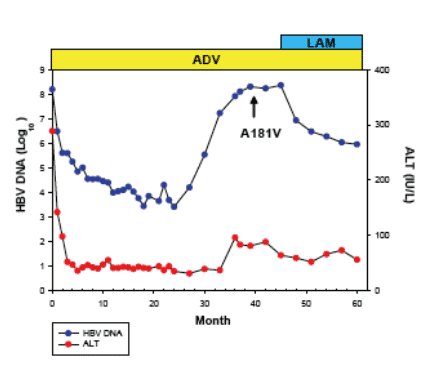 |
 |
 |
| |
Adefovir 5 years Viral & Resistance Outcomes in HBeAg-negatives
|
| |
| |
Final Analysis of Virological Outcomes and Resistance During 5 Years of Adefovir Dipivoxil Monotherapy in HBeAg-Negative Patients
Reported by Jules Levin
41st Annual Meeting of the European Association for the Study of The Liver (EASL 2006)
April 26-30, 2006, Vienna, Austria
Poster Number 483
Authors: K Borroto-Esoda,1 S Arterburn,1 A Snow,1 S Chuck,1 S Hadziyannis,2
S Locarnini,3 F Zoulim,4 and JM Pawlotsky5
1Gilead Sciences Inc., Foster City, California, USA; 2Henry Dunant Hospital, Athens, Greece;
3Victorian Infectious Disease Reference Laboratory, Melbourne, Australia;
4Institut Universitaire de France, Lyon, France; 5Hopital Henri Mondor, Paris, France
Long term treatment (4-5 years) with adefovir dipivoxil (ADV) 10 mg QD resulted in significant improvements in hepatic fibrosis, normalization of ALT and suppression of HBV DNA in the majority of patients (GS-98-438) [Hadziyannis et al., AASLD 2005].
STUDY OBJECTIVES
To investigate the incidence of adefovir resistance over 5 years of therapy in
HBeAg-negative patients.
To monitor virologic outcomes based on three categories:
-- Genotypic Resistance (M) = selection of genotypic changes at critical positions
rtA181V and/or rtN236T of the HBV polymerase (POL) regardless of HBV DNA
level and ALT outcomes
-- Virologic Resistance (M+VR) = the presence of critical genotypic changes (M)
along with HBV DNA rebound (VR); confirmed >1 log10 cp/mL increase in HBV
DNA from nadir and/or having never achieved HBV DNA suppression
<4 log10 cp/mL
-- Clinical Resistance (M + VR + ALT) = presence of critical genotypic
changes along with virologic resistance and ALT elevations (ALT >1X ULN after
normalizing ALT)
AUTHOR'S CONCLUSIONS
-- Development of ADV-associated mutations is delayed and infrequent during long-term therapy among HBeAg negative patients with chronic HBV
-- Cumulative probabilities of rtN236T and/or rtA181V mutations were 0%, 3%, 11%, 18% and 29% at 1, 2, 3, 4 and 5 years, respectively
-- Emergence of genotypic resistance is not always associated with HBV DNA rebound and increased ALT levels; cumulative probabilities of
-- Virologic resistance of 16% and Clinical resistance of 11% over 5 years
-- Addition of LAM to patients who develop ADV-associated mutations (n=10) resulted in declines of 2-6 log10 copies/mL in serum HBV DNA levels
METHODS
Patients and Treatment
HBeAg-negative patients in study GS-98-438 receiving up to 5 years of ADV
10 mg QD monotherapy (see poster #494 for full study design)
Assessments
HBV DNAa and ALT levels were collected every 4 weeks up to week 96 on the
study, and every 12 weeks thereafter
Annual genotypic analysis was performed for all patients with HBV DNA >LLOQa
-- Entire HBV RT domain sequenced
-- Conserved site mutations identified at position rtN236T and rtA181V were considered to confer resistance to adefovir dipivoxil; no novel ADV-associated
mutations identified
-- Cumulative probability of resistance calculated by Life Table analysis
a. Roche Amplicor Monitor used until May 2004 (LLOQ 400 copies/mL through Week 48, 1000 copies/mL thereafter) and Roche COBAS Taqman used after May 2004 (LLOQ 169 copies/mL).
RESULTS





|
| |
|
 |
 |
|
|